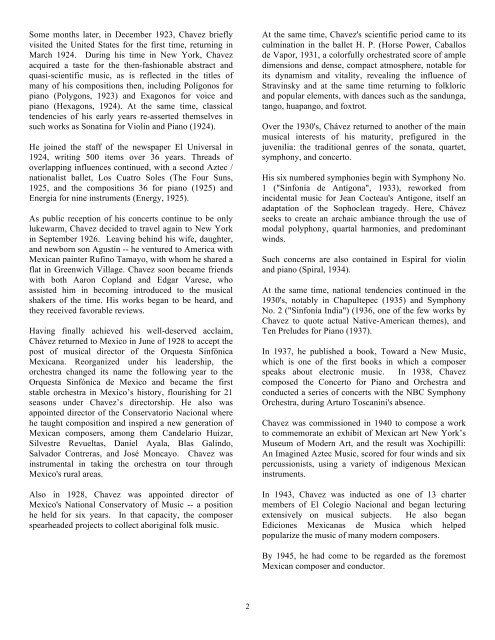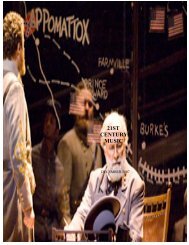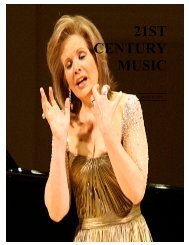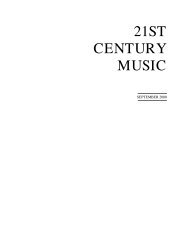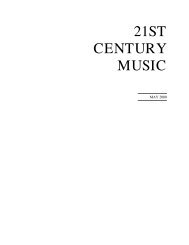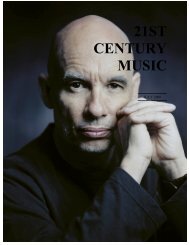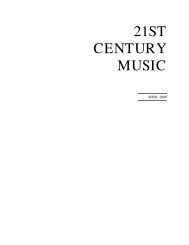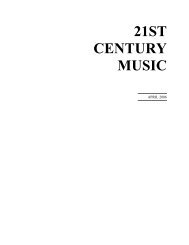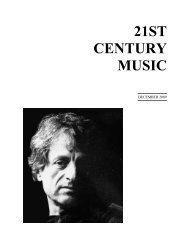Create successful ePaper yourself
Turn your PDF publications into a flip-book with our unique Google optimized e-Paper software.
Some months later, in December 1923, Chavez brieflyvisited the United States for the first time, returning inMarch 1924. During his time in New York, Chavezacquired a taste for the then-fashionable abstract andquasi-scientific music, as is reflected in the titles ofmany of his compositions then, including Polígonos forpiano (Polygons, 1923) and Exagonos for voice andpiano (Hexagons, 1924). At the same time, classicaltendencies of his early years re-asserted themselves insuch works as Sonatina for Violin and Piano (1924).He joined the staff of the newspaper El Universal in1924, writing 500 items over 36 years. Threads ofoverlapping influences continued, with a second Aztec /nationalist ballet, Los Cuatro Soles (The Four Suns,1925, and the compositions 36 for piano (1925) andEnergia for nine instruments (Energy, 1925).As public reception of his concerts continue to be onlylukewarm, Chavez decided to travel again to New Yorkin September 1926. Leaving behind his wife, daughter,and newborn son Agustín -- he ventured to America withMexican painter Rufino Tamayo, with whom he shared aflat in Greenwich Village. Chavez soon became friendswith both Aaron Copland and Edgar Varese, whoassisted him in becoming introduced to the musicalshakers of the time. His works began to be heard, andthey received favorable reviews.Having finally achieved his well-deserved acclaim,Chávez returned to Mexico in June of 1928 to accept thepost of musical director of the Orquesta SinfónicaMexicana. Reorganized under his leadership, theorchestra changed its name the following year to theOrquesta Sinfónica de Mexico and became the firststable orchestra in Mexico’s history, flourishing for 21seasons under Chavez’s directorship. He also wasappointed director of the Conservatorio Nacional wherehe taught composition and inspired a new generation ofMexican composers, among them Candelario Huizar,Silvestre Revueltas, Daniel Ayala, Blas Galindo,Salvador Contreras, and José Moncayo. Chavez wasinstrumental in taking the orchestra on tour throughMexico's rural areas.Also in 1928, Chavez was appointed director ofMexico's National Conservatory of <strong>Music</strong> -- a positionhe held for six years. In that capacity, the composerspearheaded projects to collect aboriginal folk music.At the same time, Chavez's scientific period came to itsculmination in the ballet H. P. (Horse Power, Caballosde Vapor, 1931, a colorfully orchestrated score of ampledimensions and dense, compact atmosphere, notable forits dynamism and vitality, revealing the influence ofStravinsky and at the same time returning to folkloricand popular elements, with dances such as the sandunga,tango, huapango, and foxtrot.Over the 1930's, Chávez returned to another of the mainmusical interests of his maturity, prefigured in thejuvenilia: the traditional genres of the sonata, quartet,symphony, and concerto.His six numbered symphonies begin with Symphony No.1 ("Sinfonía de Antígona", 1933), reworked fromincidental music for Jean Cocteau's Antigone, itself anadaptation of the Sophoclean tragedy. Here, Chávezseeks to create an archaic ambiance through the use ofmodal polyphony, quartal harmonies, and predominantwinds.Such concerns are also contained in Espiral for violinand piano (Spiral, 1934).At the same time, national tendencies continued in the1930's, notably in Chapultepec (1935) and SymphonyNo. 2 ("Sinfonía India") (1936, one of the few works byChavez to quote actual Native-American themes), andTen Preludes for Piano (1937).In 1937, he published a book, Toward a New <strong>Music</strong>,which is one of the first books in which a composerspeaks about electronic music. In 1938, Chavezcomposed the Concerto for Piano and Orchestra andconducted a series of concerts with the NBC SymphonyOrchestra, during Arturo Toscanini's absence.Chavez was commissioned in 1940 to compose a workto commemorate an exhibit of Mexican art New York’sMuseum of Modern Art, and the result was Xochipilli:An Imagined Aztec <strong>Music</strong>, scored for four winds and sixpercussionists, using a variety of indigenous Mexicaninstruments.In 1943, Chavez was inducted as one of 13 chartermembers of El Colegio Nacional and began lecturingextensively on musical subjects. He also beganEdiciones Mexicanas de <strong>Music</strong>a which helpedpopularize the music of many modern composers.By 1945, he had come to be regarded as the foremostMexican composer and conductor.2


